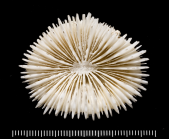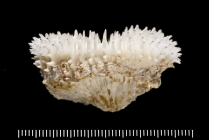WoRMS name details
Scolymia vitiensis Brüggemann, 1877
207395 (urn:lsid:marinespecies.org:taxname:207395)
unaccepted > superseded combination (basionym)
Species
marine, fresh, terrestrial
Brüggemann, F. (1877). Notes on the stony corals in the collection of the British Museum. III. A revision of the Recent solitary Mussaceae. <em>Annals and Magazine of Natural History, Series 4.</em> 20: 300-313. [details]
Holotype NHMUK 1862.2.4.49
, Note Fiji (Recent)
Holotype NHMUK 1862.2.4.49 [details]
From editor or global species database
Type locality Fiji (Recent) [details]
Description This is a mussid coral, usually solitary though older specimens commonly show bi or tri-centric calices. Single calice...
Distribution Central Indo-Pacific to Japan
Description This is a mussid coral, usually solitary though older specimens commonly show bi or tri-centric calices. Single calice specimens, which are typical, may reach 25 cm tall and 8-10 cm diameter. Septa have large teeth and are sharp. Septa do not have the very enlarged lobes and the living coral does not have the transparent tissue found in Cynarina, the other solitary mussid. There is probably only one Indian Ocean species in this genus. The genus is much more common in the Caribbean. (Sheppard, 1998 <308>)
There is a wide latitudinal variation in this species. In temperate localities it is usually solitary, saucer-shaped and less than 60 mm in diameter. In the tropics it becomes colonial and septo-costae slope up from the centre to an indistinct wall, then down to the periphery. Secondary centres may occur near the colony centre and also around the periphery. Septo-costae are sturdy with large blunt teeth. Colour: usually dark green. Abundance: seldom common but occurs in a wide range of environments. (Veron, 1986 <57>) [details]
There is a wide latitudinal variation in this species. In temperate localities it is usually solitary, saucer-shaped and less than 60 mm in diameter. In the tropics it becomes colonial and septo-costae slope up from the centre to an indistinct wall, then down to the periphery. Secondary centres may occur near the colony centre and also around the periphery. Septo-costae are sturdy with large blunt teeth. Colour: usually dark green. Abundance: seldom common but occurs in a wide range of environments. (Veron, 1986 <57>) [details]
Distribution Central Indo-Pacific to Japan
Distribution Central Indo-Pacific to Japan [details]
Hoeksema, B. W.; Cairns, S. (2025). World List of Scleractinia. Scolymia vitiensis Brüggemann, 1877. Accessed through: World Register of Marine Species at: https://www.marinespecies.org/aphia.php?p=taxdetails&id=207395 on 2025-04-04
Date
action
by
![]() The webpage text is licensed under a Creative Commons
Attribution 4.0 License
The webpage text is licensed under a Creative Commons
Attribution 4.0 License
Nomenclature
original description
Brüggemann, F. (1877). Notes on the stony corals in the collection of the British Museum. III. A revision of the Recent solitary Mussaceae. <em>Annals and Magazine of Natural History, Series 4.</em> 20: 300-313. [details]
basis of record Veron JEN. (1986). Corals of Australia and the Indo-Pacific. <em>Angus & Robertson Publishers.</em> [details]
new combination reference Huang D, Arrigoni R, Benzoni F, Fukami H, Knowlton N, Smith ND, Stolarski J, Chou LM, Budd AF. (2016). Taxonomic classification of the reef coral family Lobophylliidae (Cnidaria: Anthozoa: Scleractinia). <em>Zoological Journal of the Linnean Society.</em> 178(3): 436-481., available online at https://doi.org/10.1111/zoj.12391 [details]
basis of record Veron JEN. (1986). Corals of Australia and the Indo-Pacific. <em>Angus & Robertson Publishers.</em> [details]
new combination reference Huang D, Arrigoni R, Benzoni F, Fukami H, Knowlton N, Smith ND, Stolarski J, Chou LM, Budd AF. (2016). Taxonomic classification of the reef coral family Lobophylliidae (Cnidaria: Anthozoa: Scleractinia). <em>Zoological Journal of the Linnean Society.</em> 178(3): 436-481., available online at https://doi.org/10.1111/zoj.12391 [details]
Other
context source (Hexacorallia)
Fautin, Daphne G. (2013). Hexacorallians of the World. (look up in IMIS) [details]
additional source Cairns, S.D., B.W. Hoeksema & J. van der Land. (1999). Appendix: List of extant stony corals. <em>Atoll Research Bulletin.</em> 459: 13-46.
page(s): 35 [details]
additional source Cairns, S.D., B.W. Hoeksema & J. van der Land. (2007). as a contribution to UNESCO-IOC Register of Marine Organisms. (look up in IMIS) [details]
additional source Liu, J.Y. [Ruiyu] (ed.). (2008). Checklist of marine biota of China seas. <em>China Science Press.</em> 1267 pp. (look up in IMIS) [details] Available for editors [request]
[request]
additional source Veron JEN, Pichon M. (1980). Scleractinia of Eastern Australia – Part III. Family Agariciidae, Siderastreidae, Fungiidae, Oculinidae, Merulinidae, Mussidae, Pectinidae, Caryophyllidae, Dendrophylliidae. <em>Australian Institute of Marine Science Monograph Series.</em> 4: 1-459. [details]
additional source Veron JEN. (2000). Corals of the World. Vol. 1–3. <em>Australian Institute of Marine Science and CRR, Queensland, Australia.</em> [details]
additional source Wells JW. (1964). The recent solitary mussid scleractinian corals. <em>Zoologische Mededelingen, Leiden.</em> 39: 375-384. [details]
additional source Budd AF, Fukami H, Smith ND, Knowlton N. (2012). Taxonomic classification of the reef coral family Mussidae (Cnidaria: Anthozoa: Scleractinia). <em>Zoological Journal of the Linnean Society.</em> 166 (3): 465-529., available online at https://doi.org/10.1111/j.1096-3642.2012.00855.x [details]
additional source Pichon, M.; Benzoni, F. (2007). Taxonomic re-appraisal of zooxanthellate Scleractinian Corals in the Maldive Archipelago. <em>Zootaxa.</em> 1441: 21–33.
page(s): 33 [details]
additional source Gardiner JS (1899) On the solitary corals, collected by Dr. A. Willey. In: A. Willey's Zoological Results, Zoological Results based on Material from New Britain, New Guinea, Loyalty Islands and Elsewhere, Cambridge 2: 161-170, 176-180, pls. 19-20.
page(s): 166 [details]
additional source Fenner, D.P. (1993). Species distinctions among several Caribbean stony corals. <em>Bulletin of Marine Science.</em> 53, 1099-1116.
page(s): 1113 [details]
additional source Veron, J. E. N. (2000). Corals of the World, Volume III: Families Mussidae, Faviidae, Trachyphylliidae, Poritidae. Australian Institute of Marine Science. Townsville., volume 3, pp. 490.
page(s): 68-69 [details]
additional source Veron, J. E. N.; Pichon, M. (1979). Scleractinia of Eastern Australia, part III: Families Agariciidae, Siderastreidae, Fungiidae, Oculinidae, Merulinidae, Mussidae, Pectiniidae, Caryophylliidae, Dendrophylliidae. Australian Government Publishing Service. Canberra., volume 4, pp. 422.
page(s): 7, 242, 244-250 [details]
additional source Kühlmann, D. H. H. (2006). Die Steinkorallensammlung im Naturhistorischen Museum in Rudolstadt (Thüringen) nebst ökologischen Bemerkungen. Rudolstädter Naturhistorische Schriften, 13, 37-113
page(s): 63, 99, 113 [details]
additional source Wallace, C. C.; Fellegara, I.; Muir, P. R.; Harrison, P. L. (2009). The scleractinian corals of Moreton Bay, eastern Australia: high latitude, marginal assemblages with increasing species richness. Memoirs of the Queensland Museum, 54, 2
page(s): 10 [details]
additional source Cairns, S.D., B.W. Hoeksema & J. van der Land. (1999). Appendix: List of extant stony corals. <em>Atoll Research Bulletin.</em> 459: 13-46.
page(s): 35 [details]
additional source Cairns, S.D., B.W. Hoeksema & J. van der Land. (2007). as a contribution to UNESCO-IOC Register of Marine Organisms. (look up in IMIS) [details]
additional source Liu, J.Y. [Ruiyu] (ed.). (2008). Checklist of marine biota of China seas. <em>China Science Press.</em> 1267 pp. (look up in IMIS) [details] Available for editors
additional source Veron JEN, Pichon M. (1980). Scleractinia of Eastern Australia – Part III. Family Agariciidae, Siderastreidae, Fungiidae, Oculinidae, Merulinidae, Mussidae, Pectinidae, Caryophyllidae, Dendrophylliidae. <em>Australian Institute of Marine Science Monograph Series.</em> 4: 1-459. [details]
additional source Veron JEN. (2000). Corals of the World. Vol. 1–3. <em>Australian Institute of Marine Science and CRR, Queensland, Australia.</em> [details]
additional source Wells JW. (1964). The recent solitary mussid scleractinian corals. <em>Zoologische Mededelingen, Leiden.</em> 39: 375-384. [details]
additional source Budd AF, Fukami H, Smith ND, Knowlton N. (2012). Taxonomic classification of the reef coral family Mussidae (Cnidaria: Anthozoa: Scleractinia). <em>Zoological Journal of the Linnean Society.</em> 166 (3): 465-529., available online at https://doi.org/10.1111/j.1096-3642.2012.00855.x [details]
additional source Pichon, M.; Benzoni, F. (2007). Taxonomic re-appraisal of zooxanthellate Scleractinian Corals in the Maldive Archipelago. <em>Zootaxa.</em> 1441: 21–33.
page(s): 33 [details]
additional source Gardiner JS (1899) On the solitary corals, collected by Dr. A. Willey. In: A. Willey's Zoological Results, Zoological Results based on Material from New Britain, New Guinea, Loyalty Islands and Elsewhere, Cambridge 2: 161-170, 176-180, pls. 19-20.
page(s): 166 [details]
additional source Fenner, D.P. (1993). Species distinctions among several Caribbean stony corals. <em>Bulletin of Marine Science.</em> 53, 1099-1116.
page(s): 1113 [details]
additional source Veron, J. E. N. (2000). Corals of the World, Volume III: Families Mussidae, Faviidae, Trachyphylliidae, Poritidae. Australian Institute of Marine Science. Townsville., volume 3, pp. 490.
page(s): 68-69 [details]
additional source Veron, J. E. N.; Pichon, M. (1979). Scleractinia of Eastern Australia, part III: Families Agariciidae, Siderastreidae, Fungiidae, Oculinidae, Merulinidae, Mussidae, Pectiniidae, Caryophylliidae, Dendrophylliidae. Australian Government Publishing Service. Canberra., volume 4, pp. 422.
page(s): 7, 242, 244-250 [details]
additional source Kühlmann, D. H. H. (2006). Die Steinkorallensammlung im Naturhistorischen Museum in Rudolstadt (Thüringen) nebst ökologischen Bemerkungen. Rudolstädter Naturhistorische Schriften, 13, 37-113
page(s): 63, 99, 113 [details]
additional source Wallace, C. C.; Fellegara, I.; Muir, P. R.; Harrison, P. L. (2009). The scleractinian corals of Moreton Bay, eastern Australia: high latitude, marginal assemblages with increasing species richness. Memoirs of the Queensland Museum, 54, 2
page(s): 10 [details]
 Present
Present  Present in aphia/obis/gbif/idigbio
Present in aphia/obis/gbif/idigbio  Inaccurate
Inaccurate  Introduced: alien
Introduced: alien  Containing type locality
Containing type locality
Holotype NHMUK 1862.2.4.49 [details]
Nontype NMSR 9002, geounit Australian Exclusive Economic Zone [details]
From editor or global species database
Biology zooxanthellate [details]Type locality Fiji (Recent) [details]
Unreviewed
Description This is a mussid coral, usually solitary though older specimens commonly show bi or tri-centric calices. Single calice specimens, which are typical, may reach 25 cm tall and 8-10 cm diameter. Septa have large teeth and are sharp. Septa do not have the very enlarged lobes and the living coral does not have the transparent tissue found in Cynarina, the other solitary mussid. There is probably only one Indian Ocean species in this genus. The genus is much more common in the Caribbean. (Sheppard, 1998 <308>)There is a wide latitudinal variation in this species. In temperate localities it is usually solitary, saucer-shaped and less than 60 mm in diameter. In the tropics it becomes colonial and septo-costae slope up from the centre to an indistinct wall, then down to the periphery. Secondary centres may occur near the colony centre and also around the periphery. Septo-costae are sturdy with large blunt teeth. Colour: usually dark green. Abundance: seldom common but occurs in a wide range of environments. (Veron, 1986 <57>) [details]
Distribution Central Indo-Pacific to Japan [details]
Spelling Parascolymia vitiensis in Faure (1977). Type locality: Fiji (Veron, 1986) [details]
| Language | Name | |
|---|---|---|
| Japanese | アザミハナガタサンゴ | [details] |


